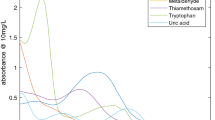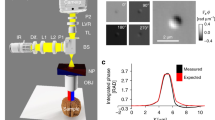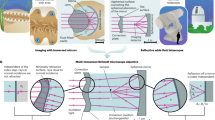Abstract
AN ultra-violet microscope having an achromatic objective designed by Brumberg and Gershgorin1 (with an aperture of 0·5) has been used for photographing living tissue cultures. The latter were grown by the hanging drop method on a quartz cover-glass. The source of light used was a high-pressure quartz mercury lamp. All radiation except that of wavelengths 254–275 µµ were prevented from reaching the object by means of filters (bromine and chlorine vapours and Corning's Red Purple Corex A, No. 986 Glass). Focusing was performed under conditions of visible light (usually in a dark field) which completely prevented the ultra-violet rays from reaching the cells previous to their being photographed. The time of exposure was 20 sec.
This is a preview of subscription content, access via your institution
Access options
Subscribe to this journal
Receive 51 print issues and online access
$199.00 per year
only $3.90 per issue
Buy this article
- Purchase on Springer Link
- Instant access to full article PDF
Prices may be subject to local taxes which are calculated during checkout
Similar content being viewed by others
References
Brumberg, E., Nature, 152, 357 (1943).
Caspersson, T., Skand. Arch. Physiol., Suppl. No. 8 (1936).
Larionow, L., and Brumberg, E., C.R. Acad. Sci. U.R.S.S., in the press.
Author information
Authors and Affiliations
Rights and permissions
About this article
Cite this article
BRUMBERG, E., LARINOW, L. Ultra-Violet Absorption in Living and Dead Cells. Nature 158, 663–664 (1946). https://doi.org/10.1038/158663c0
Issue Date:
DOI: https://doi.org/10.1038/158663c0
This article is cited by
-
Drought resistance in woody plants
The Botanical Review (1956)
-
L'�volution des structures nucl�aires dans l'ovogen�se de Caenorhabditis elegans Maupas 1900
Chromosoma (1955)
-
Ultra-Violet Absorption of Living Cells
Nature (1949)
-
Ultra-Violet Microscopy of Living Malignant Cells
Nature (1948)
Comments
By submitting a comment you agree to abide by our Terms and Community Guidelines. If you find something abusive or that does not comply with our terms or guidelines please flag it as inappropriate.



